7 树
世界上最牛的7种树
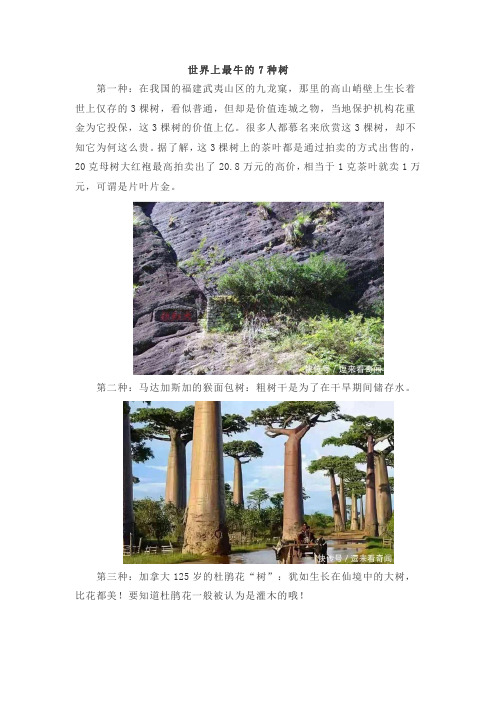
世界上最牛的7种树
第一种:在我国的福建武夷山区的九龙窠,那里的高山峭壁上生长着世上仅存的3棵树,看似普通,但却是价值连城之物,当地保护机构花重金为它投保,这3棵树的价值上亿。
很多人都慕名来欣赏这3棵树,却不知它为何这么贵。
据了解,这3棵树上的茶叶都是通过拍卖的方式出售的,20克母树大红袍最高拍卖出了20.8万元的高价,相当于1克茶叶就卖1万元,可谓是片叶片金。
第二种:马达加斯加的猴面包树:粗树干是为了在干旱期间储存水。
第三种:加拿大125岁的杜鹃花“树”:犹如生长在仙境中的大树,比花都美!要知道杜鹃花一般被认为是灌木的哦!
第四种:也门的龙血树:龙血树得名于它深红色的汁液,可以用来作为染料,或者油漆小提琴。
第五种:日本144岁的老紫藤树:覆盖1990平方米!
第六种:崖柏,崖柏是一个非常古老的植物物种,上世纪90年代曾因数量稀少未被发现宣布为灭绝物种,而后仍有发现,但属于接近灭绝的范畴,野外数量极少,而且尚未由人工引种栽培。
第七种:一株被称为“地球独子”的植物——普陀鹅耳枥,现在地球上仅遗留一株野生普陀鹅耳枥,而且它是在我国境内,这地球上最后一株普陀鹅耳枥生长在我国浙江省舟山市普陀佛顶山慧济寺的西侧,树高13.5米,树冠覆盖面积72平方米,树龄达200年以上,它是在1930年被植物学家钟观光发现的,并在1932年被著名植物学家郑万均鉴定为新树种,且命名为普陀鹅耳枥。
牛津阅读树7级培训资料

牛津阅读树7级7-1 Red Planet7-2 Lost in the Jungle7-3 The Broken Roof7-4 The Lost Key7-5 The Willow Pattern Plot 7-6 Submarine Adventure 7-7 The Motorway7-8 The Bully7-9 The Hunt for Gold7-10 Chinese Adventure7-11 Roman Adventure7-12 The Jigsaw Puzzle7-13 The Power Cut7-14 Australian Adventure7-15 The Riddle Stone Part 17-16 The Riddle Stone Part 27-17 A Sea Mystery7-18 The Big Breakfast7-19 The Joke Machine7-1 Red PlanetWilf came to play with Chip. They made a rocket ship out of bits and pieces. The rocket ship looked quite good. Wilf and Chip played in the rocket ship. They pretended to be spacemen. “The rocket is going to take off,” said Wilf. “Five…four…three…two…” Floppy ran up. He wanted to get in the rocket ship with Wilf and C hip. “Go away, Floppy,” called Chip. “The rocket is going to take off!” Nadim came to play. He had his computer with him, but he liked the look of the rocket ship. He wanted to play in it too. Just then, it began to rain. “There’s not room for all of us,” said Chip. “Let’s go inside and play with Nadim’s computer.” They played a game on the computer. It was called Red Planet. They had to land a rocket on the planet. Wilf and chip crashed the rocket. Nadim didn’t. he was good at the game. Suddenly, the magic key began to glow. Chip and Wilf pulled Nadim away from the computer and ran into Biff’s room. “Come on,” called Chip. “It’s time for an adventure.” The magic took them to a rocket ship. It took Floppy too. The rocket looked as if it was about to take off, but the door was open. Nadim wanted to look inside the rocket. “Come on,” he called. Chip didn’t want to go inside. “It may not be safe,” he said. “Why not?” said Nadim. “This is a magic adventure.” They went inside the rocket. There was nobody there. “Look at this computer,” said Nadim. Floppy jumped up and put his paw on a button. Five…four…three…two…one. The rocket began to take off. Up it went and out into space. “Oh no!” said Chip. “I don’t know where we’re going.” They began to float about inside th e rocket. Nadim found some boots. He put them on. “We must put these boots on,” he said. “They will keep us down on the floor.” They went to the window and looked out. They saw a big red planet. “We are going to land on that planet,” said Nadim. “We will soon be there.” Nadim made the rocket land. “I wouldn’t like to do that again,” he said. “It’s a good job Nadim knows about computers,” thought Wilf. “I wouldn’t like to crash here.” There was red dust all over the planet. There were red rocks and red mountains. Floppy didn’t like the look of it. He began to bark and bark. “There are no trees,” he thought. They wanted to go outside and look at the planet. They found a space buggy. They looked in the space buggy and found some spacesuits. “Let’s put thesespa cesuits on,” said Wilf. “Then we can go outside.” “Do you think it will be safe outside?” asked Chip. “I don’t know,” said Wilf. They went out on the planet in the buggy. The buggy bumped over the rocks and the red dust flew up. “I don’t like this,”though t Floppy. “I’m not made for space adventures.” Suddenly the ground cracked and a big hole opened up. “Oh help,” said Chip, Wilf, and Nadim as the buggy fell into the hole. They fell down and down inside the planet. “I don’t like this,” thought Floppy. “I want to go home.” They all landed with a bump. The buggy landed with a crash and broke in two. They were inside a big cave. “What a place!” said Wilf. “Look at it.” Chip looked at the buggy. “It’s broken,” he said. “It’s had it!” “How will we get back to th e rocket?” Floppy began to bark. There were some creatures in the cave. They looked like funny little people. “Oh no!” said Nadim. “Look at them! I hope they like us.” The creatures looked at the boys. They climbed on the broken buggy and pulled out a spac esuit. One of them turned a tap on Floppy’s spacesuit. Floppy’s spacesuit began to fill with air. It got bigger and bigger. Then Floppy began to float. “Get Floppy!” yelled Chip. “Don’t let him float away!” Wilf asked the creatures hoe to get out of the cave. They told him that there was no way out. They said that they had never been outside. Wilf had a good idea. He took a spacesuit out and he filled it with air. The spacesuit got bigger and bigger. It began to float up and up. “Hold on,” called Wilf, “and don’t let go!” The spacesuit floated up out of the cave. “We can float back to the rocket,” said Chip. “What a good idea!” “I hope it won’t go pop,” thought Floppy. They floated back to the rocket. Wilf let the air out of the spacesuit and it came down to the ground. “Good old Wilf!” said Nadim. “I don’t like floating,” thought Floppy. They went inside the rocket and it took off. Nadim turned on the computer and looked at the screen. “We’ll soon be home,” he said. Just then the magic key began to glow. “That’s good,” thought Floppy. “They won’t have to land the rocket. Dogs don’t like space adventures.” The magic took them back home. “I liked that adventure,” said Wilf. He looked at the little spacesuit. “So did I,” said Nadim, “but I’m glad I didn’t have to land that rocket again.”7-2 Lost in the JungleThe next day was Mum’s birthday. Chip had a box of chocolates for her. Kipper had made her a monkey at school. Biff didn’t know what to get. Biff asked Anneena’s mum to help her buy a plant. They went into a big greenhouse. The greenhouse was hot, and it was full of plants. “What a lot of plants!” said Biff. “It’s like a jungle in here. I don’t know which one to buy.” In the end, she found one that she liked. “I’ll get this one for Mum,” she said. The next day was Mum’s birthday and the children gave her their presents. Mum liked them all. “Thank you,” she said. “What a lovely plant, Biff!” Dad had a present for Mum. It was a plant. “I didn’t know Biff had a plant as well,” said Dad. “I don’t mind a bit,” s aid Mum. Anneena came to play with Biff and Chip. “This is from my mum,” she said. Wilma’s mum came round with a plant too. “Thank you,” said Mum. “I love plants. It’s quite like a jungle in here.” The children went to play in Biff’s room. Annena looked at the little house. “Can we have a magic adventure?” she asked. “We can if the key glows,” said Kipper. Just then the key did began to glow. The magic took them into a jungle. The jungle was full of plants. “It’s wonderful,” said Biff. “Look at that one; it’s ten times bigger than the one I gave Mum.” They saw a monkey up a tree. It jumped up and down on the branch. “That monkey looks cross,” said Kipper. “I don’t think it likes us.” “It looks like you,” said Chip. The monkey was angry with the children. It shook the branch. Thenit began to throw things at them. “We can’t stay here,” said Biff. “Come on.” They ran through the jungle, but suddenly Chip stopped. “Oh no!” he said. “Look at this.” There was a big snake in the way. “We can’t go this way,” said Chip. “Come on.” They came to a river. There were alligators asleep on the bank. “Don’t wake them up,” said Kipper. “They might get angry.” “They might like you for dinner,” said Biff. Suddenly they fell into a big bet. It pulled them up in the air. “Oh help!” called Anneena. “We’re in a trap.” The children were hanging in the net. The net was a trap to catch animals. “Help! Help!” called the children. “Let us down!” called Kipper. A man and a lady came out of the trees. They were explorers. “Don’t worry,” sa id the lady, “we’ll soon get you down.” “What are you doing in the jungle?” asked the man. “Are you lost?” “Yes,” said Biff. “I think we are.” “So are we,” said the lady, “but then we have been lost for years.” She showed them a picture. “We are looking fo r this place,” she said. “It’s called the Lost City. Nobody lives there. It’s been lost for years and years.” The children liked the explorers. They wanted to help them find the Lost City. “Maybe we can find it today,” said Kipper. “I don’t think so,” said the man. “We have been looking for years.” They came to a rope bridge. “Maybe the Lost City is over there,” said Biff. “Let’s go and see.” They began to cross the bridge. “I hope it’s safe,” said Kipper. They found a boat on the bank of the river. The boa t was full of water. “Oh good!” said the explorers. “We lost this boat years ago.” They got in the boat and paddled up the river. “Look at all the alligators!” said Chip. “I hope it’s not their dinner time.” They came to a waterfall. The explorer could not stop the boat. The paddle had broken. “Look out!” he called. “We’re going to get wet.” The boat went through the waterfall. “Oh help,” said Anneena, “I don’t like getting wet.” “Think of the alligators,” said Chip. “It’s better than getting eaten!” Behind the waterfall there were some steps. The steps went up and up for a long way. Nobody could see how far they went. “This may be the way to the Lost City,” said the lady. “Come on.” As they climbed the steps, some bats flew past them. “If this is the way to the city, I can see how it got lost,” said Anneena. “It’s such a long way up.” “It’s the Lost City!” shouted the explorers. “We have found it at last.” The man threw his hat in the air and his wife jumped up and down. ‘I knew we’d find it today,” said Kip per. Nobody had been in the city for years. There were plants and trees everywhere. Biff pulled a plant out of a wall. “This is like the one I gave Mum,” she said. They went to a big building and they opened the doors. “Oh look!” they all gasped. Everythin g inside the building was made of gold. The floor was gold and the walls were gold. There were some gold steps that went up to a gold throne. “What a wonderful place!” said Anneena. “There’s gold everywhere.” Kipper sat on the gold throne. A monkey jumped down behind him. “Look at me!” he said. “Look at that monkey behind Kipper,” said Biff. “Which one is the monkey?” asked Chip. Suddenly, the key began to glow. “It’s time to go home,” said Chip. “Goodbye,” said the explorers. “Thank you for helping us find the Lost City.” “I wish we had a magic key,” said the man. The magic took the children home. Biff still had the plant she found in the Lost City. “I’ll put it in Mum’s jungle,” she said. “I know where we can get a monkey too.”7-3 The Broken RoofIt was games time at school. The children were outside on the field. Anneena ran up to Mrs May. “Come and see something, Mrs May,” she said. Someone had broken the fence down and dumped junk on the field. Wilf was cross. “We don’t want junk on our field,” he said.“The field isn’t a dump,” said Mrs May. Then Mrs May saw something in the junk. “Do you see this?” she asked the children. “It’s a mangle. It gets the water out of wet clothes.” “How does it do that?” asked Anneena. Mrs May took the mangle into the classroom. She showed the children how it worked. First she got a big sheet and made it wet. Then Nadim turned the handle and Biff helped Mrs May put the sheet through. The water ran out of the sheet and went into a bucket. “We don’t use mangles now to get clothes dry,” said Mrs May. “What do we use?” Mrs May showed the children a picture of someone washing clothes a long time ago. Mrs May asking the children if they had any old things at home. Some of the children said they had. When Biff and Chip got home from school they looked at the little house. “The house looks very old,” said Chip, “and so do these little children. Let’s take them to school.” Kipper didn’t want them to take the little house to school. “What about the magic?” he asked Biff. “The magic won’t work if we don’t take the key,” said Biff. Some of the children took old things to school. “What a lot of things,” said Mrs May. “We can find out all about them and have a display.” Mrs May liked the little house and so did all the children. Biff and chip didn’t say that the house was magic. That was a secret. Wilf was being silly. He climbed on Mrs May’s table and pushed some books over. The books fell on to the little house with a crash. “Oh no!” said Biff. One of the books made a hole in the roof. Wilf was very upset when he saw that the roof was broken. “I’m sorry,” he said. “Perhaps I can get my dad to mend it.” Biff and Chip took the house home. Kipper was cross when he saw that it was broken. He had the magic key in his hand. “Will the magic still work?” he asked. Just then the key began to glow. A new adventure began. The magic took the children back in time. It took them to their house a long time ago. The house looked new but the roof was broken. There were three children playing outside and two men were mending the roof. “Didn’t our house look nice a long time ago?” said Biff. “But how did the roof get broken?” The children saw Biff, Chip and Kipper, and ran up to them. “Hello,” they said. “Who are you?” “I’m Biff,” said Biff. “This is Chip, and th is is Kipper. “What funny names!” said the girl. “My name is Victoria, this is Edward, and this is Will.” “What funny clothes you have!” said Will. “Not as funny as yours!” said Kipper. Kipper looked up at the men on the roof. “How did the roof get broken?” he asked. “We don’t know,” said Edward. “It’s was broken when we woke up.” “That’s funny,” said Kipper. A lady came out and called to the children. “Go inside and wash your hands,” she said. “It’s time for tea.” ‘Is that your mother?” Biff asked. “No,” s aid Edward. “That’s our cook.” The children went into the kitchen. The cook looked at Biff, Chip and Kipper. “May they stay to tea?” asked Victoria. “They have funny clothes,” said Cook, “but yes.” Biff looked round the kitchen. “This is not like our kitch en,” she said. Cook looked at Chip’s hands. “Go and wash your hands,” she said. “You can’t have tea until you do.” After tea, Cook made the children wash their hands again. Then she told Edward to take some tea to the workmen. “Come and see our rooms,” said Edward. The broken roof was in Edward’s room. “Is it mended yet?” heasked. “It won’t be long now,” said the man. “Thanks for the tea.” The children went into Victoria’s room. Victoria had a little room in her bedroom. It was the one Biff had. “We keep toys in here,” said Victoria. “Come and look.” Biff, Chip, and Kipper looked at the children’s toys. “I wish we had a horse like this,” Chip said. “So do I,” said Biff. Victoria took Biff, Chip, and Kipper into the little room. “Come and see this,” she said. “What is it?” asked Kipper. Victoria showed them a little house. She told them that her father was making it for them. “It will look like this house,” she said. “We know,” said Biff. Edward looked at Chip’s watch and Chip looked at Edward’s boat. “Do you want to swap?” asked Edward. “Yes, please,” said Chip, “then I can take the boat to school to show Mrs May.” Suddenly the magic key began to glow. “It’s time to go,” said Kipper, “but I don’t want to.” “Will you come back?” asked Edward. “We don’t know,” said Biff. “Maybe.” The magic took the children home. They looked at the little house. “The broken roof has been mended,” said Biff. “How did that happen?” “I don’t know,” said Chip, “maybe Dad mended it.” “I think the workmen in the adventure did it,” said Kipper. “We saw them.” “I think it was magic,” said Biff. “I liked that adventure best of all,” said Biff. “I liked those children long ago. I’d like to go back and see them again.” “Me too,” said Chip, looking at the boat. “Maybe I could get my watch back!”7-4 The Lost KeyKipper wanted a magic adventure but the magic key would not glow. It had not glowed for a long time. “Maybe it will glow if I keep it with me,” he thought, so he put it in his pocket. Mum had to go shopping. She wanted Kipper to go wi th her. “I want to get you some new trainers,” she said, “so come on.” Kipper forgot he had the key in his pocked. On the way to the shops, Mum let Kipper stop and play. He ran to the rocket and the key fell out of his pocket and on to the grass. “Look at me, Mum!” he called. Kipper looked in his pockets but the key was not there. “Oh no!” said Kipper. “Where is the key? I can’t have lost it, can I? But he had lost the key. Kipper wanted to go and look for the key, but Mum would not let him. It had started to rain and Mum wanted to get home. “Ask Biff and Chip to look for it,” she said. A man came to cut the grass. He cut it with a mower. The mower ran over the magic key with a clang. “What was that?” said the man. The key had broken the mower. “Grrrrr!” the man said, crossly. “Now I shall have to mend the mower.” He was so cross that he threw the magic key in a bin. Two boys came to play on the swings. One of the boys looked in the bin and found the key. “Look at this old, bent key,” he said. “What shall we do with it?” The boys took the key with them. One of them had some string. He tied the key to the string and spun it round and round. Suddenly the string broke and the key flew through the air. It hit a greenhouse with a crash and broke the glass. “Oh no!”said the boys. “Look at my greenhouse!” yelled the man. “The glass is broken.” The boys ran away as fast as they could. “Just you come back here,” called the man. Kipper had to tell Biff and Chip that he had lost the magic key. “I think I lost it by the r ocket,” he said, “but Mum wouldn’t let me look for it.” “Come on,” said Chip. ‘We must find it.” Wilf and Wilma helped them look for the lost key. Biff asked the man if he had seen it. “Yes,” said the man. “I threw it in that bin, but two boys took it out.” The children saw the two boys. They asked them if they had found the key. “Yes,”said the boys, “but we lost it again. We broke a man’s greenhouse with it.” The saw the man with the greenhouse. “We are sorry about the broken glass,” said Chip, “but could we have the key?” “Sorry,” said the man. “I sold the key to the junk shop to help pay for the glass.” The children went to the junk shop. They told the lady about the key and asked her if she had it. “Sorry,” said the lady. “I have just sold it.” The lady told them who had it. “A man came in,” she said. “He wanted some old keys.” She told them that the man had a shop down the street. The children went to the man’s shop. In the window there were pictures and paintings. “Why do you think the man wants old ke ys?” asked Wilf. Wilma looked inside the shop. It was closed and she couldn’t see the man. ‘We must get our pocket money,” said Biff. “We may have to buy the key back.” “Let’s go home, then,” said Chip. Mum went to the shop with the children. She told the man about the key and how Kipper had lost it. She asked if they could have the key back. “Yes,” said the man. “If you can find it.” The man had painted some pictures and had put lots of keys in them. All the keys had been painted. The children looked at th e pictures but they couldn’t see the magic key. They looked at all the pictures. “All the keys look the same,” said Biff. Suddenly Kipper saw a little picture. It had one key in it. “Here it is,” he said. “This is our key.” The man told them that they would have to buy the picture. Biff and Chip gave Mum their pocket money, and Mum paid the man. “It’s a lot to pay for an old key,” she said. The children pulled the key from the picture and rubbed off the paint. Then they looked at it. “The key has not glowed for a long time,” said Biff. “Perhaps it has lost its magic.” “It’s been out in the rain,” said Wilf, “and it’s been bent by a mower.” ‘It’s been through a window,” said Chip, “and it’s been stuck on a painting.” “It’s had a bad time,” said Wilma. The children wanted the key to glow. Wilma picked it up. “Do you think it will ever glow again?” she said. “Do you think the magic will still work?” “I don’t know,” said Biff. “I hope so.” But the key didn’t glow and the magic wouldn’t work. Kipper told the key about the adventures he would like to have. But still the magic wouldn’t work. The next day, Wilf and Wilma came to the house with Nadim and Anneena. The children were sorry about the key. It still wouldn’t glow and they were all very sad. “How can we make the magic work again?” asked Wilma. Anneena thought of a good idea. “Let’s remind it of the magic adventures,” she said. “Maybe that will make it work.” But the key still didn’t glow. At last the children gave up. Mum told Biff and Chip it was time for the ir friends to go home. “Cheer up,” said Mum. Kipper was sorry about the key. “It’s all my fault.” He said and he began to cry. “Don’t cry, Kipper,” said Chip. “Maybe the magic has just run out.” Biff and Chip let Kipper take the key to bed. Kipper looked at it for a long time. At last he fell asleep. Suddenly, the magic key began to glow.7-5 The Willow Pattern PlotBiff and Chip were at a car boot sale. They saw Nadim. “Nadim! Over here!” called Biff. Nadim ran to see them. He had bought something at the sale. It was a biue and white plate. He showed it to Biff and Chip. “It’s present for my mum,” said Nadim. “It’s a willow pattern plate. My mum collects them.” “Why is it called a willow pattern plate?” asked Chip. “I don’t know,” said Nadim, “but I think t he pattern tells a story.” “I wonder what the story is,” said Biff. Mum and Dad looked at Nadim’s plate.“It’s present for my mum,” said Nadim. Biff asked if Nadim could come and play. So Nadim went to play with Biff and Chip. The went up to Biff’s bedroom. “What shall we play?” asked Nadim. “I don’t know,” said Biff. Suddenly, the key began to glow. The magic took the children into a new adventure. “What’s happening?” called Nadim. “Help!” said Biff. “Everything is going blue!” “What a strange place!” said Chip. “What strange trees!” “Everything looks blue and white,” said Nadim. “We’re in the land of the willow pattern.” They were in a big garden. It had a high wall all round it and blue trees grew everywhere. “I can see water,” said Biff. “Is the garden n ext to the sea?’ “No, it’s next to a lake,” said Nadim. “There’s a bridge,” said Biff. “It’s like the one on the plate.” “I can see a little house down by the water,” said Chip. Down by the lake they saw a girl. She was all alone. “She looks unhappy,” said Biff. “Why is she all alone and why is she crying?” The girl was called Kim Shee. She lived in the little house by the lake. She had a cruel father. He would not let her go out of the garden. Kim loved a boy called Chang. She wanted to marry him. But Chang was too poor. Kim’s father wanted her to marry a rich man, but Kim loved Chang. Kim Shee heard Chang calling. “Kim Shee,” he called. “Are you alone?” “Chang!” said Kim. “How did you get here?” “I swam across the lake,” said Chang. “Nobody saw me.” “Oh!” said Kim. “You are cold and wet.” “It does not matter,” said Chang. But Kim Shee was afraid. “You must go away,” she said. “My father must not see you here.” “This garden is like a prison,” said Chang. “Your father never lets you go out.” “But what can we do?” asked Kim. “We must run away,” said Chang. “Then I can marry you.” “But how can I leave the garden?” everywhere.” “Don’t worry,” said Chang. “I will think of something.” Kim heard the sound of a twig snapping. “Someone is watching us!” she gasped. Cha ng jumped to his feet. He held up a stick. “Who is there?” he called. Then they saw Biff, Chip and Nadim. “Don’t be afraid,” said Biff. “We are friends.” “We have never seen children like you before,” gasped Chang. “How did you get into this garden?” “We didn’t mean to listen,” said Chip, “but we heard what you were saying.” “We know you want to run away,” said Biff. “But how can we?” asked Kim. “There are guards all round the garden.” Nadim had a good idea. He told them what it was. “It’s a brilliant idea!” said Chip. “I’m sure it will work,” said Biff. “But what if we are caught?” asked Chang. “Do you have a better idea?” asked Biff. “No,” said Chang. “It is our only chance.” “First, you must hid e,” said N adim. “Then, be ready to run over the bridge,” said chip. “Now we must get ready,” said Nadim. Kim had a long sash round her waist. “Give me your sash, Kim,” said Biff. Kim gave Biff her sash. Biff tied Kim’s sash to the bridge. There were lemon trees in the garden. Nadim and Chip climbed into one. They picked as many lemons as they could. Then they waited. Kim and Chang hid by the bridge. Biff held on to the end of the sash. “I hope Nadim’s idea works,” she thought. Nadim called from the tree. “Willow Pattern Plot-begin!” he said. Chip and Nadim began to shout at the guards. “Come and get us!” they yelled. “We’re over here.” The guards ran into the garden. They ran towards Kim Shee’s little house. Now that the guards were in the garden, Kim Shee and Chang could escape. Someone else ran into the garden. “My father is coming!” gasped Kim Shee. Kim and Chang began to run, but the guards saw them. “Stop them!” shouted Kim Shee’s father. Nadim and Chip threw the lemons atthe guards. Chang and Kim Shee ran over the bridge. The guards chased after them. Biff got r eady. “I hope Kim’s sash is strong!” she said. The guards ran onto the bridge. Biff pulled the sash tight. The guards tripped over it. They fell over with a crash. “You fools!” shouted Kim Shee’s father. Chip and Nadim climbed down from the lemon tree. The y ran across to find Biff. Kim Shee’s father saw them. “Catch those children,” he yelled. “Well done, Biff!” said Chip. “Kim and Chang have got away!” “I hope we get away, too,” said Biff. The magic key was glowing. “Hooray! It’s time to go!” she said. “What an adventure!” said Chip. Nadim picked up his plate and looked at it. “I wonder what happened in the real willow pattern story,” he said.7-6 Submarine AdventureWilf and Wilma had come to play at Biff and Chip’s house. It was Wilf’s birthday. “Happy birthday, Wilf,” said Biff and Chip. They gave him a big card. Wilf had a large box. “This is my birthday present,” he said. Everyone looked inside the box. “What is it?” asked Chip. “It looks like a submarine,” said Biff. “It’s a kind of submarine,” said Wilf. “It explores the sea bed.” “That’s right,” said Wilma. “It goes to the bottom of the sea.” “What a brilliant present!” said Biff. The submarine looked like a car. It had big windows and it had headlights. Wilf put the headlights on. “It’s brilliant,” said Chip. Biff looked at the magic key. Suddenly it began to glow. It was time for a new adventure. “I wonder where the key will take us,” said Wilf. The magic took the children to the sea, where there were lots of boats. Chip pointed to a yellow submarin e. “Look at that one,” he said. “It looks just like Wilf’s submarine!” The children went to look at the submarine. “I wish we could look inside,” said Chip. Just then a hatch began to open and a man looked out. The man peered at them. “Hello!” he said. “I’m Professor Tangle.” “How do you do,” said Wilf. “My new crew?” said Professor Tangle. “You look a bit young.” “We’re not your new crew,” shouted Wilf. “How do you do!” Professor Tangle didn’t hear properly. He got things muddled up. “You know what to do?”he said. “That’s good! Get on board,” went on the Professor. “And tell me your names.” “I’m Biff,” said Biff, “and this is Wilma. This is Wilf, and this is Chip.” “No, it’s not a ship,” said the Professor. “It’s a diving machine.” “We know that,” said Wilf. “We’ve never been in one,” said Wilma, “and we’re not your new crew!” “You flew?” said Professor Tangle. “I didn’t see an aeroplane. Now shall we go?” Everyone smiled, and they all climbed into the submarine. Professor Tangle shut the hatch. ‘There’s not much room,” said Wilma. “No,” said Biff. “I hope it doesn’t leak.” “Of course you can speak,” said the Professor. Professor Tangle started the engines. “It’s time to dive,” he said. The submarine went under the water. “Glub! Glub! Glub!” it went. Everyon e looked outof the window. They could see fish everywhere. “It’s wonderful,” said Chip. “It’s amazing to be under the sea.” “You can’t see?” said Professor Tangle. “Look out of the window, then.” “Come on, crew!” said Professor Tangle. “Time to do some wo rk. Push that button, Biff. Press that handle, Wilf. Pull that lever, Chip.” “We’re not the crew!” yelled Biff. “Things might go wrong.” “Sing a song?” said Professor Tangle. “There’s no time for that. There’s far too much to do.” The submarine began to di ve. It went deeper and deeper. “Glub! Glub! Glub!” it went. “Where are we heading?” shouted Chip. “Will we dive deep?” “No, you can’t go to sleep,” said Professor。
二年级上册美术教案《第7课 树的联想》沪教版

二年级上册美术教案《第7课树的联想》沪教版一. 教材分析《第7课树的联想》是沪教版二年级上册美术教材的一课。
本课的主要内容是让学生通过观察、联想和创作,了解树的形态特征,培养学生的创新思维和美术表现能力。
教材中提供了多种树的图片,以及一些与树相关的创意作品,旨在引导学生从不同的角度去观察和思考,激发他们的创作潜能。
二. 学情分析二年级的学生已经具备了一定的观察和表达能力,他们对树有一定的认知,但可能缺乏对树形态特征的深入理解和创新思维的培养。
因此,在教学过程中,教师需要引导学生从不同的角度去观察树,激发他们的创新思维,并通过实际的创作活动,培养他们的美术表现能力。
三. 教学目标1.让学生了解树的形态特征,培养学生的观察能力和创新思维。
2.引导学生通过绘画和手工制作等方式,表达自己对树的联想和创意。
3.培养学生的审美能力和合作意识,提高他们的美术表现能力。
四. 教学重难点1.重点:观察树的形态特征,培养创新思维和美术表现能力。
2.难点:如何引导学生从不同的角度去观察和思考,激发他们的创作潜能。
五. 教学方法1.观察法:引导学生观察树的形态特征,培养观察能力。
2.启发式教学法:通过问题引导,激发学生的创新思维。
3.实践教学法:引导学生通过绘画和手工制作等方式,实际操作,提高美术表现能力。
4.小组合作教学法:培养学生的合作意识和团队精神。
六. 教学准备1.教材:《第7课树的联想》沪教版。
2.图片素材:多种树的图片。
3.美术用品:画纸、画笔、彩泥、剪刀、胶水等。
4.其他材料:树叶、树枝等自然物品。
七. 教学过程1.导入(5分钟)教师通过提问方式引导学生回顾对树的认识,了解树的形态特征。
例如:“你们知道树有哪些形态特征吗?”“你们曾经观察过树的哪些方面?”等。
2.呈现(10分钟)教师展示多种树的图片,引导学生从不同的角度去观察和思考。
同时,展示一些与树相关的创意作品,激发学生的创新思维。
3.操练(10分钟)教师引导学生进行实际的绘画和手工制作活动。
离散数学7-树
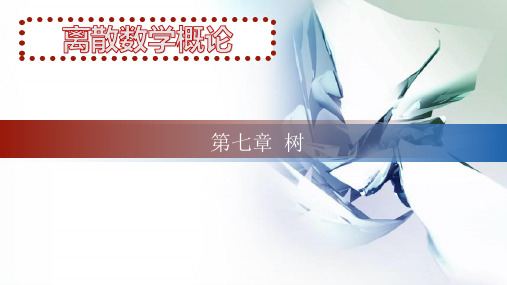
(b)
(a)
V5
2
1
V7
8
9
V2
V4
2
3
V8
5
V1
V1
V4
V5
1
3
V7
V6
8
V4
2
V8
5
6
V1
1
V5
6
V7
V6
8
3
V8
5
6
V7
9
V3
(e)
V3
(f)
(g)
22
V2
V3
(h)
五.应用举例——求最小生成树
例3 用管梅谷算法求下图的最小生成树。
23
五.应用举例——求最小生成树
例3 用管梅谷算法求下图的最小生成树。
成圈。
首先证明T无简单回路。对n作归纳证明。
(i) n=1时,m=n-1=0,显然无简单回路;
(ii)假设顶点数为n-1时无简单回路,现考察顶点数是n的情况:此时至少有一
个顶点v其次数d(v)=1。因为若n个顶点的次数都大于等于2,则不少于n条边,但这与
m=n-1矛盾。
删去v及其关联边得到新图T’,根据归纳假设T’无简单回路,再加回v及其关联
边又得到图T,则T也无简单回路。
再由图的连通性可知,加入任何一边后就会形成圈,且只有一个圈,否则原图
中会含圈。
9
二. 基本定理——证明
证明(4):(3)(4),即证一个无圈图若加入任一边就形成圈,
则该图连通,且其任何一边都是桥。
若图不连通,则存在两个顶点vi和vj,在vi和vj之间没有路,若
加边(vi,vj)不会产生简单回路,但这与假设矛盾。由于T无简单回
七月份水果树的管理措施
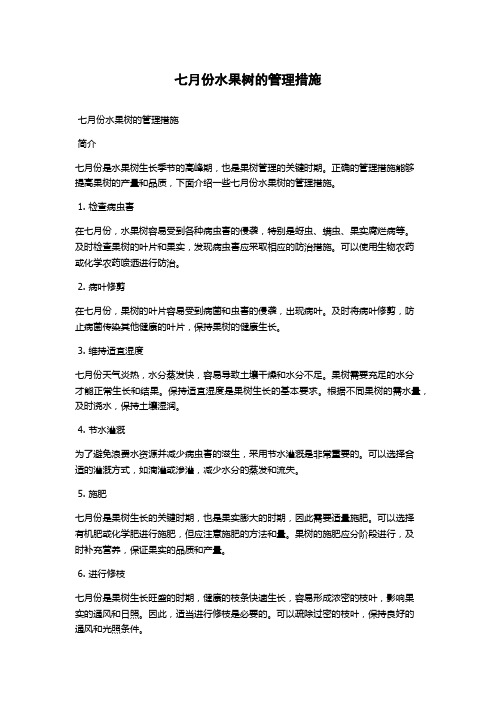
七月份水果树的管理措施七月份水果树的管理措施简介七月份是水果树生长季节的高峰期,也是果树管理的关键时期。
正确的管理措施能够提高果树的产量和品质,下面介绍一些七月份水果树的管理措施。
1. 检查病虫害在七月份,水果树容易受到各种病虫害的侵袭,特别是蚜虫、螨虫、果实腐烂病等。
及时检查果树的叶片和果实,发现病虫害应采取相应的防治措施。
可以使用生物农药或化学农药喷洒进行防治。
2. 病叶修剪在七月份,果树的叶片容易受到病菌和虫害的侵袭,出现病叶。
及时将病叶修剪,防止病菌传染其他健康的叶片,保持果树的健康生长。
3. 维持适宜湿度七月份天气炎热,水分蒸发快,容易导致土壤干燥和水分不足。
果树需要充足的水分才能正常生长和结果。
保持适宜湿度是果树生长的基本要求。
根据不同果树的需水量,及时浇水,保持土壤湿润。
4. 节水灌溉为了避免浪费水资源并减少病虫害的滋生,采用节水灌溉是非常重要的。
可以选择合适的灌溉方式,如滴灌或渗灌,减少水分的蒸发和流失。
5. 施肥七月份是果树生长的关键时期,也是果实膨大的时期,因此需要适量施肥。
可以选择有机肥或化学肥进行施肥,但应注意施肥的方法和量。
果树的施肥应分阶段进行,及时补充营养,保证果实的品质和产量。
6. 进行修枝七月份是果树生长旺盛的时期,健康的枝条快速生长,容易形成浓密的枝叶,影响果实的通风和日照。
因此,适当进行修枝是必要的。
可以疏除过密的枝叶,保持良好的通风和光照条件。
7. 加强树体保护七月份的高温天气有利于果实的生长,但也容易造成树体水分流失和晒伤。
果树的树干和树皮容易受到日晒和蚜虫的侵害。
因此,需要加强树体保护。
可以在树干周围搭建遮阳网,防止直射阳光照射,也可以使用生物农药进行喷洒,预防病虫害的侵袭。
8. 注意病害和害虫的预防七月份是果树生长季节,也是各种病虫害滋生的季节。
果农需要定期巡视果园,观察果树是否有病虫害症状。
一旦发现病虫害,应立即采取相应的防治措施,避免病虫害蔓延,保证果树的健康生长。
7树成行与9树成行问题 - 副本
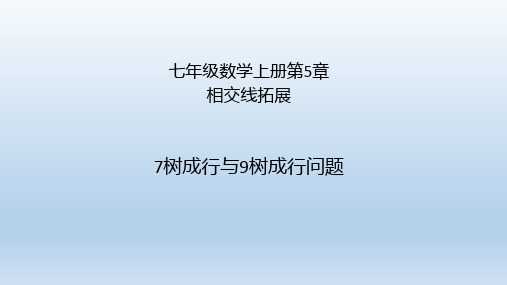
7树成行与9树成行问题
问题1:7棵树排成6行,每行3棵树,怎么排?
如图,在任意三角形内部任意画3条相交于一点的 线段,加上三角形的3个顶点,共有7个交点,在 交点位置种上7棵树,怎么排?
如图,画一个田字格,在每一行和每一列交点 位置处各种一棵树,再加上两条对角线,正好 把9棵树种成了8行,每行3棵树。 当然,画成不规则或不对称的田字格也行。
问题3:9棵树排成9行,每行3棵树,怎么排?
构造三角形法第一种思路: 如图:在大三角形内嵌套一个小三角 形,五角星位置种上9棵树,则共有9 行,每行3棵树。
9棵树排成9行,每行3棵树的第二种思路。
仍然是构造两个三角形,让第三行两 棵树(红星)的位置稍微发生一些变 化即可(两幅图对比就可发现): 如图:在大三角形内嵌套一个小三角 形,五角星位置种上9棵树,则共有9 行,每行3棵树。
In rows just half a score; And let there be in each row three, Solve this; I ask no more.” 这几句诗翻译过来,可以是上面诗题中的那几句话。若用通俗的话来说,则可以是 现有9棵树要栽,要求每行栽3棵,并恰好栽成10行。应该怎样去栽呢?你能帮忙栽 出来吗?
当然,也可以用类似于2进制中的0和1来画图表示如下(其 中,1代表树):
3行5列,每行种3棵树,共能看到有10行是3棵树在同一条直 线上。
10101
01110
10101
问题4:9棵树排成10行,每行3棵树,怎么排?
共栽九棵树,要求成十行; 行行要三棵,任务谁敢当?
问题出处:在英国1821年出版的一本古老的趣味算题集里,记载着据说是著名数学家 和力学家依沙克·牛顿(1642—1727)提出和做过的一道算题。原文是以诗的词句写出 来的: “Your aid I want,nine trees to plant,
美术大树教案7篇

美术大树教案7篇(实用版)编制人:__________________审核人:__________________审批人:__________________编制单位:__________________编制时间:____年____月____日序言下载提示:该文档是本店铺精心编制而成的,希望大家下载后,能够帮助大家解决实际问题。
文档下载后可定制修改,请根据实际需要进行调整和使用,谢谢!并且,本店铺为大家提供各种类型的教育资料,如工作总结、工作计划、作文大全、心得体会、申请书、演讲稿、教案大全、其他范文等等,想了解不同资料格式和写法,敬请关注!Download tips: This document is carefully compiled by this editor.I hope that after you download it, it can help you solve practical problems. The document can be customized and modified after downloading, please adjust and use it according to actual needs, thank you!Moreover, this store provides various types of educational materials for everyone, such as work summaries, work plans, essays, experiences, application forms, speeches, lesson plans, and other sample articles. If you want to learn about different data formats and writing methods, please pay attention!美术大树教案7篇我们可以根据教案中的活动安排预测问题,每个教案都应该包括教学的步骤和时间安排,以便我们掌握教学进度,下面是本店铺为您分享的美术大树教案7篇,感谢您的参阅。
系统安全分析方法7 事件树分析法

2、事件树分析法步骤
4) 事件树定量计算
第一节 系统安全分析方法 七、事件树分析
在煤气中的中毒事故设(P69) P(B)=0.1,P(C)=0.2,P(D)=0.3, P(E)=0.4,响应的有:
成功事件发生的概率为:
中毒事件发生的概率为:
死亡事件发生的概率为:
2、事件树分析法步骤
4) 事件树定量计算 煤气中毒事件中失败(中毒或者死亡)的总概率为:
C
个人防护失败 C
成功 护抢救成功
D
撤离失败 D
E
抢救失败 E
险肇 中毒
中毒 死亡
x5
从图中可以看出: 要考虑煤气中毒,最基本原因是有煤气存在,在考虑煤气存在(A)后,这时 A就决定了下一个状态有没有人在煤气区,若有人在场B存在,就决定了要考虑 人有防护没有,如果没有防护,则考虑撤离问题等,这样一直到最终结果E。
马尔科夫预测法适用领域:
企业规模 市场占有率 选择服务点 设备更新等的预测。
第一节 系统安全分析方法 七、事件树分析(ETA)
1、事件树分析法及其理论基础
2)事件树分析法的理论基础 (4)马尔科夫链数学描述
定义:设随机过程 (t ) 只能取可列个值 r1 , r2 ,rn ,, 把 (t ) rn 称为在时刻 t系统处于状态 En (n 1,2,) 若在已知时刻 t ,系统处于 E n 状态的条件下,在时刻 ( t ) 系统所处的状态情况与t时刻以前所处状态 (t )为时间连续,状态离散的马尔可夫 无关,则称 过程。而状态的转移只能在 t t n (n 1,2,)发生的马尔 可夫过程称为马尔可夫链。 从定义中可知,马尔可夫链是状态离散,时间连续 的马尔可夫过程。
7事件树分析例题ppt课件

(B)温度测量调整系统调整有效
恢复正常。 (E)安全状态,操作工紧
急关停反应系统
(B) 不安全状态:温度测控系
(C)超温报 警仪报警, 提醒操作工
(D)操作工采取对应措施奏 效,恢复正常运行
统失效,温度继续升高
(C) 不安全状态:操作工已 道, 可采取措施
(E)关停反应系统
(C) 不安全状态:操作工不 知道,无人采取措施;
(D´)未能关停 反应系统,继
续采取其它紧 急措施
冷 冻 盐 水 流 量 减 少
Page 2
成功:超温报
警仪报警(B)
操作工采取恢复流量措施奏 效,流量、温度恢复正常(C)
关闭反应系 统成功(D)
温度升高到报警线
恢复流量措施失败(C)
关闭应系统失 败(D)
(B)报警仪失效未报警,操 作工不知道,无人采取措施
Page 5
2-2-060
(A)乙炔泄漏
,乙炔浓度
达到启动风
机、报警浓 度
风机启动, 同时报警器 报警,提醒操 控人员,(B)
测报系统失 效,风机报警 没有启动,乙 炔浓度达到 燃爆浓 度(B)
风机作用阻止乙 炔达到燃爆浓度, 同时操控人接警 采取关闭泄漏源 措施(C)
汇流排间产生火 源会引燃(爆)泄漏 的乙炔,发生火灾 、爆炸事故;会 引爆乙炔气瓶颈 发生更大爆炸
·乙 炔燃Байду номын сангаас会引爆乙炔
瓶,造成更大的爆 炸事故
(A)乙炔泄漏
(D)安全状态, 泄漏源关闭;
风机排除已泄漏的乙 炔,危险消除
(B)不安全状态:风机启动,
操控人员已知道
(C)不安全状态:操控人
采取关闭泄漏源措施
亲密无间的七仙女树
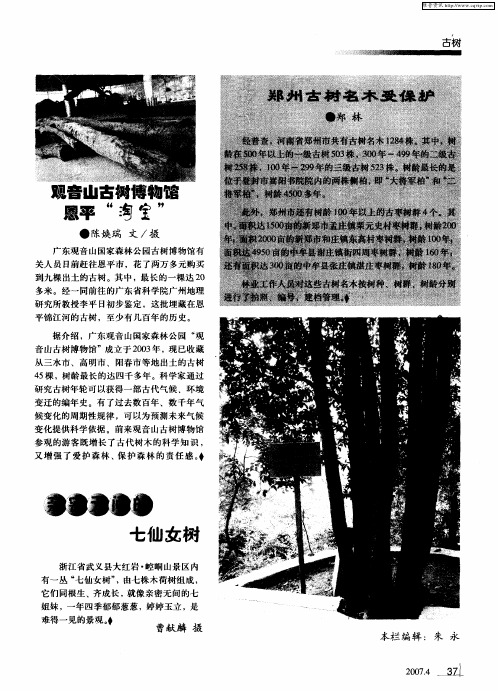
维普资讯
古树
观音 山古树 博物链
恩平 “ 宝 ” 匈
● 陈焕瑞 文 /摄
广东观 音山国家森林公 园古树博物馆 有 关人 员 日前赶往恩平市 ,花 了两万 多元购 买 到九棵 出土的古树 。其 中,最 长的一棵达 2 0
多米 。经一 同前往的广东省科学院广州地理 研 究所教授李平 日初步鉴定 ,这批埋藏在 恩
平锦 江河的古树 ,至少有几百年的历 史。 据介绍 ,广东 观音山国家森林公 园 “ 观 音山古树博 物馆”成立于 2 0 年 ,现 已收藏 03 从三 水市 、高明市 、阳春市等地 出土 的古树
4 棵 ,树龄最长 的达 四千 多年。科学家通过 5
研究古树年轮可 以获得一 部古代气候 、环境 变迁 的编年 史。有 了过去 数百年、数千年气 候变化的周期性规 律 ,可 以为预 测未来气候 变化提供科学依据 。前来观 音山古树博物馆 参观 的游客既增 长了古代树 木 的科 学知 识 , 又增 强 了爱护 森 林 、 护 森 林 崆峒 山景区 内 有一 丛 “ 仙女树” 七 ,由七株木 荷树组成 , 它们 同根 生、齐成长 , 就像 亲密无间的七 姐妹 , 一年 四季郁 郁葱葱 ,婷婷玉立 ,是
难得一见的景观。 ◆
曹献麟 摄
本栏 编辑 : 朱 永
2 7 3i 0. z 04
六年级数学下册教案-大树有多高(7)-苏教版

六年级数学下册教案大树有多高(7)苏教版让我们来看看这个课题的教学内容。
我们将会使用苏教版六年级数学下册的教材,主要涉及第7课“测量大树的高度”。
在这一课中,学生们将学习如何使用简单的工具和测量方法来估算大树的高度。
在这个课题中,教学难点和重点主要在于如何正确使用测量工具和测量方法来估算大树的高度。
学生们需要理解并掌握使用绳子、尺子等工具进行测量的原理和方法。
为了顺利开展课堂教学,我已经准备好了相应的教具和学具。
教具包括一根长绳子、一把尺子和一些标记笔。
学具则包括笔记本、铅笔和尺子。
接着,我会向学生们介绍使用绳子和尺子进行测量大树高度的方法。
我会演示如何将绳子从树上垂下来,并用尺子测量绳子的长度,从而估算出大树的高度。
我会强调测量时的注意事项,如保持绳子垂直、确保尺子准确读数等。
在学生们掌握了测量方法后,我会组织他们进行随堂练习。
我会让学生们分成小组,每组选择一棵大树进行实际测量。
他们会用绳子、尺子和标记笔来测量大树的高度,并将结果记录在笔记本上。
在进行了一段时间的实践后,我会组织学生们进行板书设计。
我会邀请几名学生上台,将他们测量大树高度的过程和结果展示在黑板上。
这样不仅能帮助学生们巩固所学知识,还能激发他们的学习兴趣。
我会设计一些作业来巩固学生们的学习成果。
一道典型的作业题目是:“请你用绳子和尺子测量一下教室天花板的高度,并将结果记录下来。
”这道题目将让学生们将所学知识应用到实际生活中,培养他们的实践能力。
在课后,我会进行反思和拓展延伸。
我会思考课堂教学的效果,看看学生们是否掌握了测量方法,并找出需要改进的地方。
同时,我还会鼓励学生们进行拓展延伸,如尝试测量其他物体的高度,或者探索更准确的测量方法。
重点和难点解析:在今天的课堂教学中,我发现了几个需要重点关注和讲解的细节。
学生们在测量大树高度时,对于如何正确使用绳子和尺子进行测量的方法理解不够深入。
他们需要明确测量时的注意事项,如保持绳子垂直、确保尺子准确读数等。
高大陆七棵树大通三题
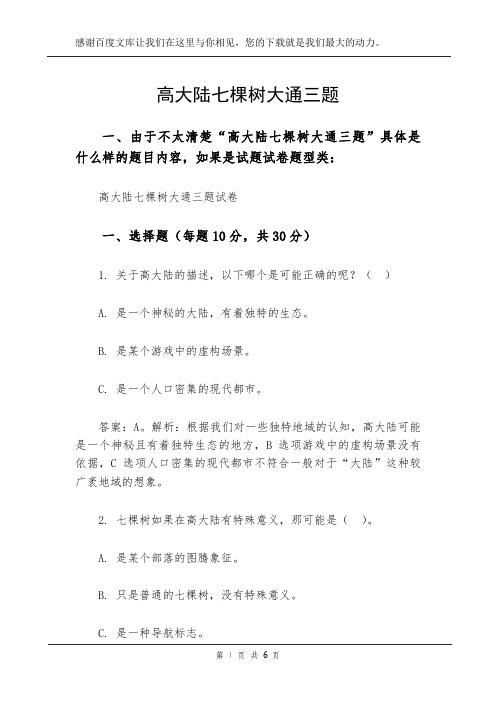
高大陆七棵树大通三题一、由于不太清楚“高大陆七棵树大通三题”具体是什么样的题目内容,如果是试题试卷题型类:高大陆七棵树大通三题试卷一、选择题(每题10分,共30分)1. 关于高大陆的描述,以下哪个是可能正确的呢?()A. 是一个神秘的大陆,有着独特的生态。
B. 是某个游戏中的虚构场景。
C. 是一个人口密集的现代都市。
答案:A。
解析:根据我们对一些独特地域的认知,高大陆可能是一个神秘且有着独特生态的地方,B选项游戏中的虚构场景没有依据,C选项人口密集的现代都市不符合一般对于“大陆”这种较广袤地域的想象。
2. 七棵树如果在高大陆有特殊意义,那可能是()。
A. 是某个部落的图腾象征。
B. 只是普通的七棵树,没有特殊意义。
C. 是一种导航标志。
答案:A。
解析:在很多地域文化中,树木可能会成为部落的图腾象征,B选项不太符合“如果有特殊意义”这个前提,C选项导航标志一般会有更明显的标识性,单纯七棵树不太可能是导航标志。
3. 大通如果是高大陆的一个地方,那它可能以什么出名?()A. 丰富的矿产资源。
B. 独特的舞蹈文化。
C. 先进的科技研发。
答案:A。
解析:通常对于一个地域来说,丰富的矿产资源是比较容易成为出名的因素,B选项独特的舞蹈文化没有太多依据表明和大通相关,C选项先进的科技研发在一个可能比较神秘原始的高大陆中的一个地方不太容易出现。
二、简答题(每题20分,共40分)1. 描述一下你想象中的高大陆的生态环境。
答案:我想象中的高大陆生态环境很独特呢。
可能有高大的奇异植物,它们的叶子是五颜六色的,像是天然的艺术品。
动物也都是些奇特的种类,比如长着翅膀的老虎模样的生物,它们在天空和陆地之间自由穿梭。
还有一些湖泊,湖水是亮晶晶的,像是充满了魔法元素,周围围绕着会发光的小鱼。
解析:从一种充满想象力的角度出发,考虑到高大陆是一个比较神秘的概念,所以构建出一个充满奇幻元素的生态环境。
2. 如果七棵树是文化象征,阐述一下它可能代表的文化内涵。
大树教案反思7篇
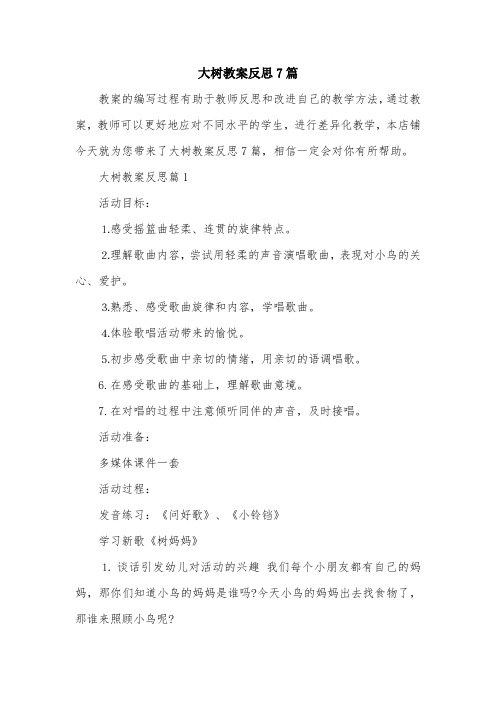
大树教案反思7篇教案的编写过程有助于教师反思和改进自己的教学方法,通过教案,教师可以更好地应对不同水平的学生,进行差异化教学,本店铺今天就为您带来了大树教案反思7篇,相信一定会对你有所帮助。
大树教案反思篇1活动目标:⒈感受摇篮曲轻柔、连贯的旋律特点。
⒉理解歌曲内容,尝试用轻柔的声音演唱歌曲,表现对小鸟的关心、爱护。
⒊熟悉、感受歌曲旋律和内容,学唱歌曲。
⒋体验歌唱活动带来的愉悦。
⒌初步感受歌曲中亲切的情绪,用亲切的语调唱歌。
6.在感受歌曲的基础上,理解歌曲意境。
7.在对唱的过程中注意倾听同伴的声音,及时接唱。
活动准备:多媒体课件一套活动过程:发音练习:《问好歌》、《小铃铛》学习新歌《树妈妈》⒈谈话引发幼儿对活动的兴趣我们每个小朋友都有自己的妈妈,那你们知道小鸟的妈妈是谁吗?今天小鸟的妈妈出去找食物了,那谁来照顾小鸟呢?⒉结合动画引导幼儿欣赏第一段歌曲是谁在照顾小鸟呀?它是怎么照顾的呢?⒊引导幼儿边听第一段音乐,边模仿树妈妈晃动的样子。
(一遍初步的尝试,另一遍引导幼儿合着拍子轻柔的摇)⒋引导幼儿欣赏第二段动画。
小鸟睡着了,可是会发生什么事情呢?⒌教师范唱歌曲,幼儿欣赏。
⒍鼓励幼儿学唱歌曲。
⒎引导幼儿有感情的、轻柔的演唱歌曲,表现出对小鸟的关心、爱护。
⒏幼儿尝试分角色表演。
音乐游戏:树和小鸟教师扮演树妈妈,幼儿扮演小鸟,根据歌曲内容表演相关的动作,当风来了,雨来了的时候,请小鸟蹲下不动,树妈妈保护好小鸟。
活动反思:《树妈妈》是一首较为经典的儿童歌曲,具有浓郁的摇篮曲风格,旋律优美流畅、轻柔抒情。
歌曲借助幼儿熟悉的树形象,把幼儿带人了一个和谐、温暖的童话世界。
中班幼儿已经能够体验到妈妈对自己的爱了,通过情感迁移他们能够更好地理解歌曲内容,自然地表达歌曲所蕴含的美好情愫。
大树教案反思篇2设计思路:本次活动虽无只接表达母亲与孩子之间的爱意,但朴实的字里行充满着大人与小孩之间那种相互依偎,相互关心、形影不离的添犊之情。
蓝狐狸和七棵树寓言故事
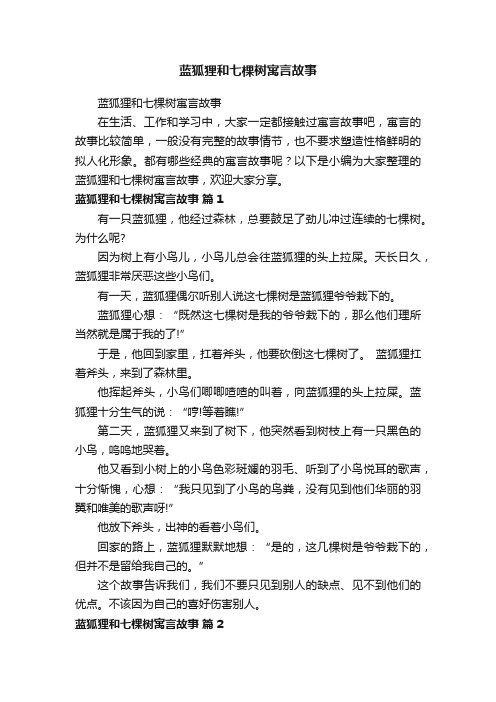
蓝狐狸和七棵树寓言故事蓝狐狸和七棵树寓言故事在生活、工作和学习中,大家一定都接触过寓言故事吧,寓言的故事比较简单,一般没有完整的故事情节,也不要求塑造性格鲜明的拟人化形象。
都有哪些经典的寓言故事呢?以下是小编为大家整理的蓝狐狸和七棵树寓言故事,欢迎大家分享。
蓝狐狸和七棵树寓言故事篇1有一只蓝狐狸,他经过森林,总要鼓足了劲儿冲过连续的七棵树。
为什么呢?因为树上有小鸟儿,小鸟儿总会往蓝狐狸的头上拉屎。
天长日久,蓝狐狸非常厌恶这些小鸟们。
有一天,蓝狐狸偶尔听别人说这七棵树是蓝狐狸爷爷栽下的。
蓝狐狸心想:“既然这七棵树是我的爷爷栽下的,那么他们理所当然就是属于我的了!”于是,他回到家里,扛着斧头,他要砍倒这七棵树了。
蓝狐狸扛着斧头,来到了森林里。
他挥起斧头,小鸟们唧唧喳喳的叫着,向蓝狐狸的头上拉屎。
蓝狐狸十分生气的说:“哼!等着瞧!”第二天,蓝狐狸又来到了树下,他突然看到树枝上有一只黑色的小鸟,呜呜地哭着。
他又看到小树上的小鸟色彩斑斓的羽毛、听到了小鸟悦耳的歌声,十分惭愧,心想:“我只见到了小鸟的鸟粪,没有见到他们华丽的羽翼和唯美的歌声呀!”他放下斧头,出神的看着小鸟们。
回家的路上,蓝狐狸默默地想:“是的,这几棵树是爷爷栽下的,但并不是留给我自己的。
”这个故事告诉我们,我们不要只见到别人的缺点、见不到他们的优点。
不该因为自己的喜好伤害别人。
蓝狐狸和七棵树寓言故事篇2有一只蓝狐狸,他颠末丛林,总要鼓足了劲儿冲过持续的七棵树。
为什么呢?由于树上有小鸟儿,小鸟儿总会往蓝狐狸的头上拉屎。
天长日久,蓝狐狸很是厌烦这些小鸟们。
有一天,蓝狐狸无意听别人嗣魅这七棵树是蓝狐狸爷爷栽下的。
蓝狐狸心想:“既然这七棵树是我的爷爷栽下的,那么他们理所虽然就是属于我的了!”于是,他回抵家里,扛着斧头,他要砍倒这七棵树了。
蓝狐狸扛着斧头,来到了丛林里。
他挥起斧头,小鸟们唧唧喳喳的叫着,向蓝狐狸的头上拉屎。
蓝狐狸异常气愤的说:“哼!等着瞧!”第二天,蓝狐狸又来到了树下,他溘然看到树枝上有一只玄色的小鸟,呜呜地哭着。
七棵树上七样果大班数学教案
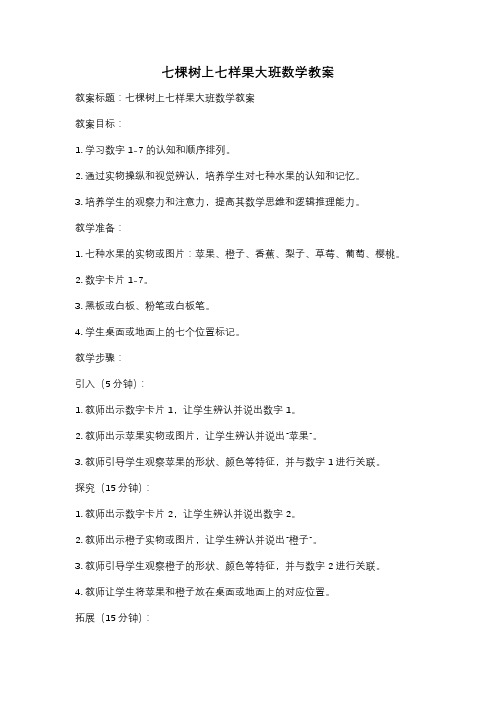
七棵树上七样果大班数学教案教案标题:七棵树上七样果大班数学教案教案目标:1. 学习数字1-7的认知和顺序排列。
2. 通过实物操纵和视觉辨认,培养学生对七种水果的认知和记忆。
3. 培养学生的观察力和注意力,提高其数学思维和逻辑推理能力。
教学准备:1. 七种水果的实物或图片:苹果、橙子、香蕉、梨子、草莓、葡萄、樱桃。
2. 数字卡片1-7。
3. 黑板或白板、粉笔或白板笔。
4. 学生桌面或地面上的七个位置标记。
教学步骤:引入(5分钟):1. 教师出示数字卡片1,让学生辨认并说出数字1。
2. 教师出示苹果实物或图片,让学生辨认并说出“苹果”。
3. 教师引导学生观察苹果的形状、颜色等特征,并与数字1进行关联。
探究(15分钟):1. 教师出示数字卡片2,让学生辨认并说出数字2。
2. 教师出示橙子实物或图片,让学生辨认并说出“橙子”。
3. 教师引导学生观察橙子的形状、颜色等特征,并与数字2进行关联。
4. 教师让学生将苹果和橙子放在桌面或地面上的对应位置。
拓展(15分钟):1. 教师出示数字卡片3-7,让学生辨认并说出相应的数字。
2. 教师分别出示梨子、草莓、葡萄、樱桃的实物或图片,让学生辨认并说出相应的水果名称。
3. 教师引导学生观察每种水果的特征,并与相应的数字进行关联。
4. 教师让学生将所有七种水果放在桌面或地面上的对应位置。
总结(5分钟):1. 教师复习数字1-7的顺序排列,并让学生一起说出来。
2. 教师复习七种水果的名称,并让学生一起说出来。
3. 教师鼓励学生互相交流,描述每种水果的特征。
巩固(10分钟):1. 教师随机出示数字卡片,让学生说出相应数字并找到对应的水果。
2. 教师随机出示水果实物或图片,让学生说出相应的数字。
扩展活动:1. 学生分组,每组选择一种水果,用数字卡片和实物或图片进行配对游戏。
2. 学生自由创作,用七种水果进行数学游戏或故事编写。
教案评估:1. 教师观察学生在识别数字和水果方面的准确性和独立性。
平凡的树作文7篇
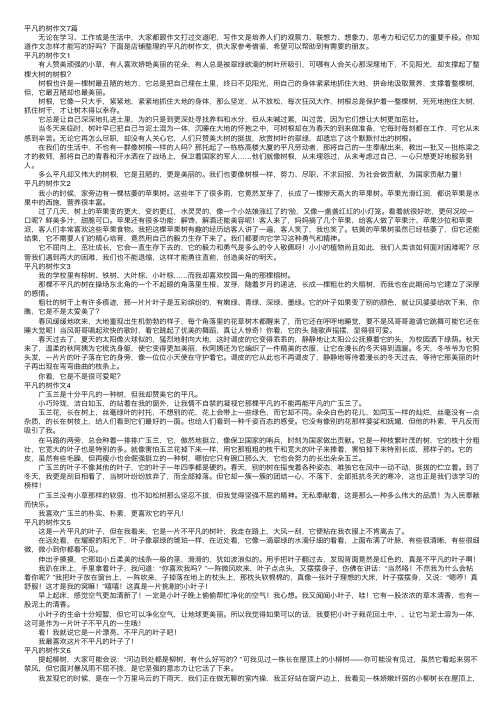
平凡的树作⽂7篇 ⽆论在学习、⼯作或是⽣活中,⼤家都跟作⽂打过交道吧,写作⽂是培养⼈们的观察⼒、联想⼒、想象⼒、思考⼒和记忆⼒的重要⼿段。
你知道作⽂怎样才能写的好吗?下⾯是店铺整理的平凡的树作⽂,供⼤家参考借鉴,希望可以帮助到有需要的朋友。
平凡的树作⽂1 有⼈赞美顽强的⼩草,有⼈喜欢娇艳美丽的花朵,有⼈总是被翠绿欲滴的树叶所吸引,可哪有⼈会关⼼那深埋地下,不见阳光,却⽀撑起了整棵⼤树的树根? 树根也许是⼀棵树最丑陋的地⽅,它总是把⾃⼰埋在⼟⾥,终⽇不见阳光,⽤⾃⼰的⾝体紧紧地抓住⼤地,拼命地汲取营养,⽀撑着整棵树,但,它最丑陋却也最美丽。
树根,它像⼀只⼤⼿,紧紧地,紧紧地抓住⼤地的⾝体,那么坚定,从不放松,每次狂风⼤作,树根总是保护着⼀整棵树,死死地抱住⼤树,抓住树⼲,才让树⽊得以幸存。
它总是让⾃⼰深深地扎进⼟⾥,为的只是到更深处寻找养料和⽔分,但从未喊过累,叫过苦,因为它们想让⼤树更加茁壮。
当冬天来临时,树叶早已把⾃⼰与泥⼟混为⼀体,沉睡在⼤地的怀抱之中,可树根却在为春天的到来做准备,它每时每刻都在⼯作,可它从未感到⾟苦。
⽆论它再怎么尽职,却没有⼈关⼼它,⼈们只赞美⼤树的挺拔,欣赏树叶的翠绿,却遗忘了这个默默付出的树根。
在我们的⽣活中,不也有⼀群像树根⼀样的⼈吗?那托起了⼀栋栋⾼楼⼤厦的平凡劳动者,那将⾃⼰的⼀⽣奉献出来,教出⼀批⼜⼀批栋梁之才的教师,那将⾃⼰的青春和汗⽔洒在了战场上,保卫着国家的军⼈……他们就像树根,从未埋怨过,从未考虑过⾃⼰,⼀⼼只想更好地服务别⼈。
多么平凡却⼜伟⼤的树根,它是丑陋的,更是美丽的。
我们也要像树根⼀样,努⼒、尽职、不求回报,为社会做贡献,为国家贡献⼒量!平凡的树作⽂2 我⼩的时候,家旁边有⼀棵枯萎的苹果树。
这些年下了很多⾬,它竟然发芽了,长成了⼀棵掺天⾼⼤的苹果树。
苹果光滑红润,都说苹果是⽔果中的西施,营养很丰富。
过了⼏天,树上的苹果变的更⼤,变的更红,⽔灵灵的,像⼀个⼩姑娘涨红了的'脸,⼜像⼀盏盏红红的⼩灯笼。
- 1、下载文档前请自行甄别文档内容的完整性,平台不提供额外的编辑、内容补充、找答案等附加服务。
- 2、"仅部分预览"的文档,不可在线预览部分如存在完整性等问题,可反馈申请退款(可完整预览的文档不适用该条件!)。
- 3、如文档侵犯您的权益,请联系客服反馈,我们会尽快为您处理(人工客服工作时间:9:00-18:30)。
在右图中, 实边所示的子图是图G 的一棵生成树T, d,e,f为T的树枝, a,b,c 为T的弦, 在弦上加弦a, 产生G的一个 初级回路aed, 还可在T上分别加弦b,c 又可形成2个初级回路bdf和cef, 这3 个回路中的每个回路都只含一条弦, 其余的边都是树枝, 这样的回路称为基本回路。
定义7.3 设T是n阶m条边的无向连通图G的一棵生 成树,设e1,e2, … ,em-n+1为T的弦,设Cr为T 添加弦er产生的G的回路, r=1,2, …, m-n+1。 则称Cr为对应于弦er的基本回路,称 {C1,C2,Cm-n+1}为对应生成数T的基本回路系统,
第七章 树 §7.1 无向树及生成树
定义 7.1 连通无回路的无向图称为无向树,简称树,常用T 表示树。(即树是不包含回路的连通图) 平凡图称为平凡树。 若无向图G至少有两个连通分支,且每个连通分 支都是树,则称G为森林。 在无向树中,悬挂顶点称为树叶,度数大于或 等于2的顶点称为分支点。
例 7.1 判断下列哪些图是树?
在下图中,(2)为(1)的一棵生成树T, (3)为T的余树,注意:余树不一定是树。 一个无向连通图,如果它本身不是树,它的 生成树是不唯一的。但所有的连通图都具有生成 树。事实上,若G是连通图,又G中无回路,则 G本身就是树。 a a e a e b b b d d c c c d (1) (2) (3)
定理7.2
设T是n阶非平凡的无向树,则T中 至少有两片树叶。 证 : 因为T是非平凡树,所以T中每个顶点的度 数都大于等于1, 设T有k片树叶, 则有(n-k) 个顶点度数大于等于2,由握手定理及定理7.1 可知2m=∑d(vi) ≥ k+2(n-k) 由定理7.1可知,m=n-1,将此结果代入上式后 解得 k ≥ 2. 以上两个定理给出了无向树的主要性质, 利用这些性质和握手定理,可以画出阶数n比 较小的所有非同构的无向树。
③ 若r元树T是有序的, 则称T为r元有序树
④ 若r元正则树T是有序的,则称T为r元正
则有序树
⑤ 若T是r元正则树,且所有树叶的层数相
同,则称T为r元完全正则树
⑥ 若r元完全正则树T是有序树,则称T是
r元有序完全正则树
例 7.13
。 。 。 。。 。 。 。。 二元(叉)树 二元(叉)正则树
。 。 。 。 。 。 。
例7.5:无向树G有2个2度顶点,1个3度顶点, 3个4度顶点,则其1度顶点数为多少?
解:由握手定理 2m=∑d(vi)
及定理7.1
n = m+1
设G有t个1度顶点, 则有下列关系式 2 x 2+3+4 x 3+t =2 m =2 x(n-1) =2 x(2+1+3+t-1) 解得:t = 9
例 7.6:无向树G有8片树叶,2个3度分支点, 其余分支点均为4度,问G有多少个4度分支点? 画出其非同构的情况。
T的以a为根的子树,简称根子树。
例 7.12
根树T中,v2 , v3为兄弟,他们为v1 的儿子, 而v3有儿子v4 , v5 , v6 , v5有儿子v7和v8 , v3为v7 , v8的祖先,v7 , v8为v3的后代… T '为T的根子树。
定义7.8 设T为根树,若将T中层数相同的
顶点都标定次序,则称T为有序树. 根据根树T中每个分支点儿子数以及是否 有序,可以将根树分成下列各类; 定义7.9 设T为一棵根树 ① 若T的每个分支点至多有r个儿子, 则称 T为 r 元树 (r叉树) ② 若T的每个分支点都恰好有r个儿子, 则 称它为 r 元正则树
定理7.3 任何无向连通图G都有生成树 证明:如果G中无回路,则G为树,因此G 本身就是G的生成树。若G中含回路C,则在C 中任意删去一条边,不影响图的连通性。若 所得图中还有回路,重复此过程,直到所得 图中无回路为止,设最后的图为T,则T为G 的生成树。 推论1 设G是n阶m条边的无向连通图, 则m ≥ n-1。 推论2 设G是n阶m条边的无向连通图,T为G 的生成树,则T的余树T'中含有 m-n+1边(即T'有m-n+1条弦)。
在下图中, Ca=aed, Cb=dbf, Cc=cef,为对应生成树T的基本回路, {Ca,Cb,Cc}为T的基本回路系统。 一个连通图G对应不同的生成树的 基本回路及基本回路系统可能不同, 但基本回路的个数是相同的,都等于 m-n+1 a
d e
b
f c
定义 7.4 设T是n阶连通图G的一棵生成树, 称T的n-1 个树枝对应的G的n-1个割集(每个割集只含一 个树枝,其余的边都是弦)S1 ,S2, … ,Sn-1为对 应生成树T的G的基本割集, 称{S1 ,S2, … ,Sn-1} 为对应生成树T的基本割集系统。
3 4
d
c
例7.10:用Kruskal算法求下图的最小生成树。 。
1 5 5
。
5 2
。
4
4 3
。
3 2 5
。
1
。 。
。W(T)=1+1+2+3+2+5 =14 1
5
。 。
4 4 3
5
5 5 2
W(T)=1+1+2+3+2+5
。
3 2
。
1
=14
。
。
作 业
P171 7.1 7.7
7.2 7.8
§7.2 根树及其应用
。 。 。 。 。 。 。 。 。 。 。 。 。 。 。 。 。 。 。 。 。 。
。
。 。 。 。 。 。 。 。
。 。
。 。 。 。 。 。 。 。 。 。 。 。 。 。 。 。
。 。 。
。
。
。 。 。
。 。 。
。
。 。 。
。 。
。 。 。 。 。 。
定义7.2 设T是无向图G的生成子图并且为树,则称T 为G的生成树。 G在T中的边称为T的树枝,G不在T中的边 称为T的弦。 T的所有弦的集合的导出子图称为T的余树 图中,橙色边表示 生成树,黑色边组 成其余树。可见, 余树可能不连通, 也可能含回路。
例 7.11 下图(1)为一棵根树。v0为树根, v1,v4, v3, v6, v7为树叶, v2, v5为内点, v0, v2, v5为均为分支 点, 由于在根树中有向边的方向均一致, 故可省 掉其方向, 如图(2)
v0
v2 v4 v5 v6 v7 v3
v0
v2 v4 v3 v5 v6
v1
v1
(1)
v1 v2 v4 v5 v3 v2 v4 v1 v3 v5 v1 v2 v3
v4
v5
(a) (b) (c) 解: 图(a)是树, 因为它连通又不包含回路。 图(b), (c)不是树, 因为图(b)虽连通但有回路, 图(c)虽无回路但不连通。 在图(a)中, v1、 v4、 v5为均为树叶, v2、 v3均为 分支点。
设n阶无向连通带权图G=<V,E,W>有m条 边,不妨设G中无环(否则可先删去),算法为: (1) 将m条边按权从小到大顺序排列,设为 e1,e2, … ,em。 (2) 取e1在T中,然后依次检查e2, … ,em ,若ej (j=2,3, …,m)与T中的边不能构成回路,则 取ej在T中,否则放弃ej,考虑下一条边,直 至j>m。 (3) 算法停止时得到的T为G的最小生成树。
设D是有向图, 如果略去有向边的方向所得 无向图为一棵无向树,则称D为有向树。 其中根树最为重要。 定义 7.6 设T是n(n ≥ 2)阶有向树,若T中有一个顶点的 入度为0,其余的顶点的入度均为1,则称T为 根树, 入度为0的顶点称为树根, 入度为1出度为0的顶点称为树叶, 入度为1出度不为0的顶点称为内点, 内点和树根统称为分支点,
例 7.2
判断下列哪些图是树?
(1)和(4)是树,(4)为平凡树。 (2)有回路,不是树。 (3)不连通,也不是树。但它有2个连通分支,因此 它是森林。 (1)所示的树中, a、b、e、f是树叶,c、d为分支点。
定理 7.1 设G=<V,E>,则下面各命题是等价的: (1)G连通而不含回路(G是树)。 (2)G中每对顶点之间存在唯一的路径。 (3)G中无回路且 n = m+1。 (4)G是连通的且 n = m+1。 (5) G中没有回路,但在任何两个不同的顶点 之间加一条新边,在所得的图中得到唯 一的一条初级回路。 (6) G是连通的且G中任何边均为桥。 (7) G是连通的,但删除任何一条边后,就不 连通了。 其中n为G中顶点数,m为边数。
解:设G有t个4度分支点,则有下列关系式 8 x 1+2 x 3+ t x 4 =2 x(8+2+t-1) 解得:t = 2
则G中共有12个顶点,11条边,度数序列之 和为22, △ (Ti)=4, (Ti)=1, 度序列为: 1,1,1,1,1,1,1,1,3,3,4, 4 其非同构的图形为:
其非同构的图形为:
例7.8 用避圈法求下图所示的最小生成树 解: W(T)=1+2+3+4+5
=15 5 b 5 6 6 a
1
f 5 4
5 e 2
注意:
最小生成树的结 点数与原图相等, 3 边的数目比原图 c 少。
d
例7.9:铺设一个连接各个城市的光纤通6
a
2
1 8 4
2
h b
7
4
6
g
在下图中, T的树枝d 对应G的一个割 集{d,b,a}, e对应一个割集{e,a,c}, 树枝f 对 应一个割集{f,c,b}。 3个树枝对应的G的割集的特点是:每 个割集中只含一个树枝,其余的边都是弦。 这样的割集称为基本割集。
